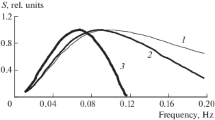Abstract
The anisotropic radiation of infrasonic waves from moving aurorae is explained by a shock wave model. The acoustic waves, as observed on the ground at a site ahead of the moving aurora, are amplified in the direction parallel to the auroral motion by superposition of wave fronts if the auroral form is moving at supersonic speed.
Similar content being viewed by others
References
Chrzanowski, P., Green, G., Lemmon, K. T., and Young, J. M., J. Geophys. Res., 66, 3727 (1961).
Wilson, C. R., and Nichparenko, S., Nature, 214, 1299 (1967).
Bhattacharyya, B. K., Canad. J. Phys., 38, 1279 (1960).
Maeda, K., and Watanabe, T., J. Atmos. Sci., 21, 15 (1964).
Piddington, J. H., Space Sci. Rev., 3, 724 (1964).
Author information
Authors and Affiliations
Rights and permissions
About this article
Cite this article
WILSON, C. Infrasonic Pressure Waves from the Aurora: a Shock Wave Model. Nature 216, 131–133 (1967). https://doi.org/10.1038/216131a0
Received:
Issue Date:
DOI: https://doi.org/10.1038/216131a0
- Springer Nature Limited





